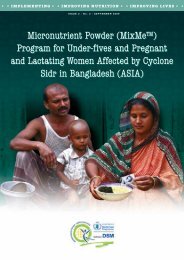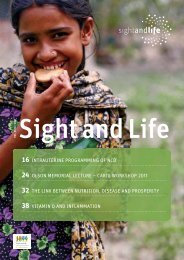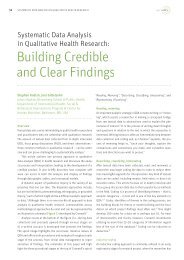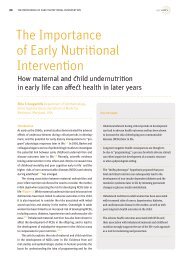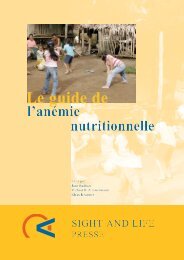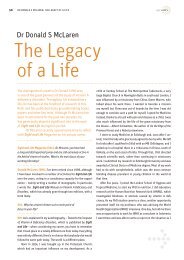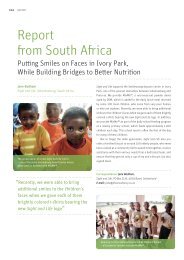Sight and Life Magazine 1/2011
Sight and Life Magazine 1/2011
Sight and Life Magazine 1/2011
Create successful ePaper yourself
Turn your PDF publications into a flip-book with our unique Google optimized e-Paper software.
SIGHT AND LIFE | VOL. 25 (1) | <strong>2011</strong>WHAT'S NEW91Considering that it is estimated that in 2010 more than42 million children under the age of five years were overweightor obese, of whom nearly 35 million were livingin developing countries, these recommendations are timely.Their purpose is to guide efforts by UN Member States indesigning new <strong>and</strong>/or strengthening existing policies onfood marketing communications to children.The recommendations can be accessed in a number oflanguages from www.who.int/dietphysicalactivity/publications/recsmarketing/en/A Cochrane Review of Vitamin ASupplementation for Preventing Morbidity <strong>and</strong>y in Children from Six Months13YearsThis review by Aamer Imdat <strong>and</strong> coworkers includes 43r<strong>and</strong>omized trials representing 215,633 children <strong>and</strong> showsthat giving vitamin A capsules to children aged six monthsto five years can reduce death <strong>and</strong> some diseases. The resultsof 17 of the studies have been summarized <strong>and</strong> indicate thatvitamin A reduces the overall risk of death by 24%. Death dueto measles, respiratory infections or meningitis was not specificallyreduced, but vitamin A could reduce new occurrencesof diarrhea <strong>and</strong> measles. When people took very large dosesof vitamin A, they were more likely to vomit within two days.In the author’s opinion, given the evidence that vitaminA supplementation (VAS) causes a considerable reductionin child mortality, further placebo-controlled trials of VASin children between six months <strong>and</strong> five years of age are notrequired. There is, however, a need for further studies thatcompare different doses <strong>and</strong> delivery mechanisms (for example,fortification). In addition, as the effects of VAS on relevantpathogens <strong>and</strong> disease pathways are not well understood,these could be further researched, together with the elucidationof the relationship (if any) between vitamin A <strong>and</strong> growth.The reviewers also give implications for practice, giventhat national <strong>and</strong> regional programs of VAS are in placein over 70 countries worldwide <strong>and</strong> may be among the mostcost-effective public health interventions. As more than190 million children are vitamin A deficient around theglobe, a reduction in their risk of mortality by 24% could savealmost 1 million lives a year. These interventions respondto an immediate need for adequate nutrition; however, theyare not ideal long-term solutions to the underlying problem.Fortification, food distribution programs <strong>and</strong> horticulturaldevelopments may provide more permanent relief.Furthermore, if vitamin A reduces mortality by preventingmeasles, widespread vaccination will reduce the relativecontribution of vitamin A supplementation. Until such longtermsolutions are in place, supplementation should continue.The researchers also recommend that, as access to vitamin Aincreases, it will be important to continue to identify at-riskgroups <strong>and</strong> deliver supplements to them. They strongly recommendvitamin A supplementation to children under five inareas at risk of VAD. The exact nature of how these programsshould be structured <strong>and</strong> administered – the dose, frequency,<strong>and</strong> duration of intervention – is less certain. The researchersalso suggest that VAS for pregnant <strong>and</strong> lactating mothers <strong>and</strong>other efforts to promote the delivery of vitamin A (such asincreased rates <strong>and</strong> duration of breastfeeding) may requirefurther attention.Finally, it is worth noting that two additional Cochranereviews recently investigated the effects of vitamin A duringthe neonatal period (infants aged one to six months) <strong>and</strong> willbe available shortly.For the full review, go tohttp://onlinelibrary.wiley.com/o/cochrane/clsysrev/articlesCD008524/frame.html



